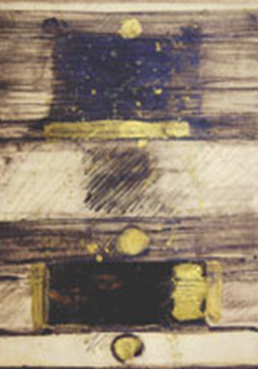Ali Imam
This is a collection of articles archived for the excellence of their content. Readers will be able to edit existing articles and post new articles directly |
Ali Imam
A maestro’s students unite
By Amra Ali
It was on a nostalgic note that the Indus Gallery, Karachi held an exhibition last month of the works by students of Ali Imam. Several painters who got their early training from the late maestro have continued to explore and cultivate the visual vocabulary which was vibrant in the 1970s. Imam Sahib, himself a painter, stood like a guiding force and a father figure to the art community in Pakistan, first after his return from Paris in the 60s as the first Principal of the Central Institute of Arts and Crafts, and later as the director of the Indus Gallery.
From the crevices of my childhood memories are glimpses of the towering Imam Sahib; I can still feel his energy when I would accompany an aunt to exhibition openings and hear him speak with passion about the new works by Laila Shahzada, Lubna Agha, Ahmad Parvez and many others. Several years later, after becoming a professional I would see him engage in critiques and discussions, and one knew that if there was to be an honest and intellectual engagement with an artist’s work or on any facet of art history, the right person to go to would be Imam Sahib. From within the simple and down to earth ambience of the original premises of the Indus Gallery (his gallery-cum-home in PECHS), stemmed the fountain of learning and sharing that Ali Imam nurtured, providing a roof for the sustenance of ideas.
The exhibition titled ‘Shagird 1970’ was conceived by some of the students of Imam Sahib who tutored under him either at the CIAC or privately at his gallery. In a modest brochure, Rashed Arshed, the only colleague of Imam Sahib participating in the show, briefly comments on the early struggle of keeping the CIAC afloat at a time when even the salaries of the staff were in arrears for months. Arshed Sahib later took charge of the CIAC after the older master “set out on a bigger journey. The Indus Gallery, which made history in introducing some of the best known artists of Pakistan”, he writes.
Along with Rashed Arshed, among the artists who have made a name for themselves and are part of this show are Nahid Raza, Imran Mir, Shakil Siddiqui, Norjehan Bilgrami, and Wahab Jafffer, Tabinda Chinoy as well as Akram Spaul, Omar Farid.and Shezi Kazmi and Sunayia Kazmi. The latter four have displayed their work from time to time and have not made an impact as strong or consistent as the former seven. Other inclusion in the show, like those of Raana Hyder, Anjum Mahmood, and Mohammad Mansoor appear like distractions and prompts one to ask why these artists were clumped together with the more mature lot. While also being students of Imam, they have not shown a growth or reached a level of commitment that is equal to that of other artists in this exhibition.
The first step towards understanding the influence and role of Imam Sahib in grooming artists, would be to note that he did not impose his intellectual ideals on to others In its entirety, the body of work shown here displays a diversity of directions, and each artist’s individualistic expression. Therefore, Imam Sahib’s intervention can been seen as being engaged with each artist’s own level of creative potential and quest. Wahab Jaffar, a long time friend to the artist, a teacher and himself a serious collector, has continued in his search for evolving imagery inspired by Ahmad Parvez. At the same time, Imran Mir has one large work in the show that defines the intensity of his concerns of space as an issue throughout his career as a painter. Shakil Siddiqui, on the other hand paints in super realism, and has been creating imagery that baffles the eye with its intricacy of detail. Noorjehan Bilgrami’s works on paper are part of her engagement with non occidental and Far Eastern aesthetics.
The directions may be diverse, but they all seem to be disparate, stories half told. It would be fair to say that Ali Imam was an ustad, not only to these few, but was engaged with an entire generation of serious artists, critiquing their work and pushing them to explore new directions. Now, without that centre that held us together, we seem to be a community without a figure head, each for his own.



